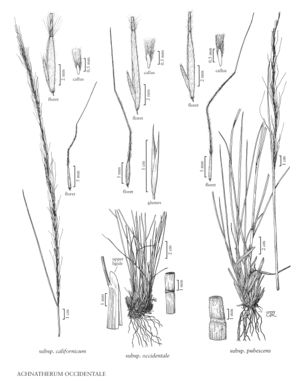Difference between revisions of "Achnatherum occidentale subsp. occidentale"
FNA>Volume Importer |
FNA>Volume Importer |
||
| Line 1: | Line 1: | ||
{{Treatment/ID | {{Treatment/ID | ||
|accepted_name=Achnatherum occidentale subsp. occidentale | |accepted_name=Achnatherum occidentale subsp. occidentale | ||
| − | |accepted_authority= | + | |accepted_authority= |
|publications= | |publications= | ||
|common_names=Western needlegrass | |common_names=Western needlegrass | ||
| Line 16: | Line 16: | ||
-->{{Treatment/Body | -->{{Treatment/Body | ||
| − | |discussion=<p>Achnatherum occidentale subsp. occidentale grows above 2400 m, primarily in California. It differs from A. occidentale subsp. pubescens in having culms that are glabrous throughout and awns with terminal segments that are usually pilose. One specimen from Idaho has been seen; it has the palea/lemma ratio of subsp. californicum but the pilose terminal awn segments, slender habit, and purplish coloration of subsp. occidentale.</p> | + | |discussion=<p><i>Achnatherum occidentale </i>subsp.<i> occidentale</i> grows above 2400 m, primarily in California. It differs from <i>A. occidentale </i>subsp.<i> pubescens</i> in having culms that are glabrous throughout and awns with terminal segments that are usually pilose. One specimen from Idaho has been seen; it has the palea/lemma ratio of <i></i>subsp.<i> californicum</i> but the pilose terminal awn segments, slender habit, and purplish coloration of <i></i>subsp.<i> occidentale</i>.</p> |
|tables= | |tables= | ||
|references= | |references= | ||
| Line 25: | Line 25: | ||
-->{{#Taxon: | -->{{#Taxon: | ||
name=Achnatherum occidentale subsp. occidentale | name=Achnatherum occidentale subsp. occidentale | ||
| − | + | |authority= | |
| − | |authority= | ||
|rank=subspecies | |rank=subspecies | ||
|parent rank=species | |parent rank=species | ||
| Line 33: | Line 32: | ||
|family=Poaceae | |family=Poaceae | ||
|illustrator=Cindy Roché | |illustrator=Cindy Roché | ||
| + | |illustration copyright=Utah State University | ||
|reference=None | |reference=None | ||
|publication title= | |publication title= | ||
|publication year= | |publication year= | ||
|special status= | |special status= | ||
| − | |source xml=https:// | + | |source xml=https://jpend@bitbucket.org/aafc-mbb/fna-data-curation.git/src/f50eec43f223ca0e34566be0b046453a0960e173/coarse_grained_fna_xml/V24/V24_172.xml |
|subfamily=Poaceae subfam. Pooideae | |subfamily=Poaceae subfam. Pooideae | ||
|tribe=Poaceae tribe Stipeae | |tribe=Poaceae tribe Stipeae | ||
Revision as of 20:18, 16 December 2019
Culms 14-50 cm tall, 0.3-1 mm thick, internodes glabrous. Basal sheaths mostly glabrous, often ciliate or sparsely tomentose at the throat; collars usually without tufts of hair at the sides; blades 0.3-2 mm wide when flat, usually convolute and 0.1-0.2 mm in diameter. Panicles 5-20 cm; longest branches 1.5-4 cm. Glumes often purplish; lemmas with apical pubescence similar in length to the basal awn pubescence; awns 15-42 mm, first 2 segments always pilose, terminal segment usually pilose, hairs becoming shorter distally, occasionally scabridulous or smooth.
Discussion
Achnatherum occidentale subsp. occidentale grows above 2400 m, primarily in California. It differs from A. occidentale subsp. pubescens in having culms that are glabrous throughout and awns with terminal segments that are usually pilose. One specimen from Idaho has been seen; it has the palea/lemma ratio of subsp. californicum but the pilose terminal awn segments, slender habit, and purplish coloration of subsp. occidentale.
Selected References
None.
